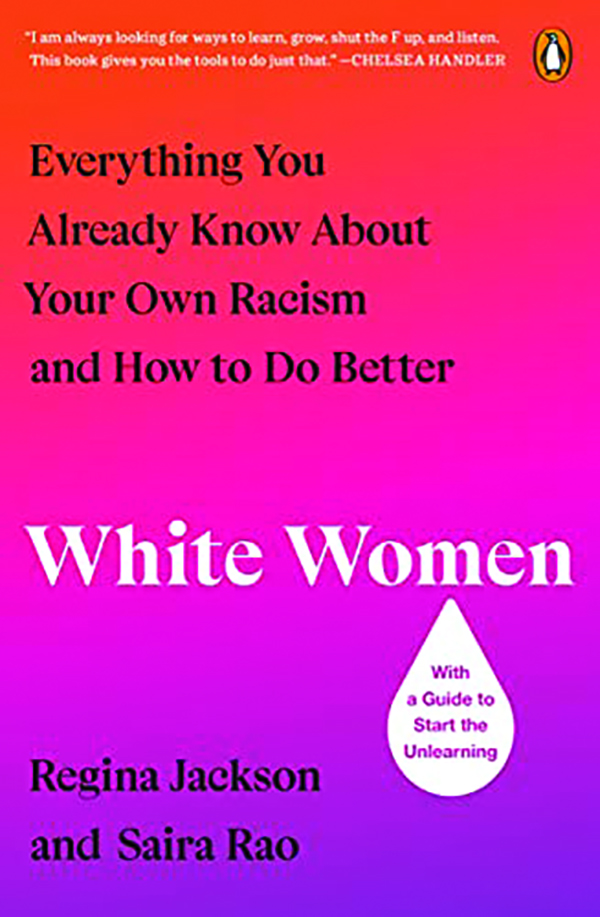
Saira Rao’s latest book of grift, reviewed
Wilfred Reilly
For a long time, as a regular user of Twitter, I thought that Saira Rao was a parody account. Her latest book has not done a great deal to convince me otherwise.

At root, the theme of Saira Rao and Regina Jackson’s White Women: Everything You Already Know about Your Own Racism and How to Do Better is simple: The United States is a white supremacist, genocidal, racist society, and white female citizens of this modern Reich need to hire Rao and Jackson’s Race2Dinner company to reeducate them past their internalized pathologies. All of this is said explicitly quite early on, in the book’s lengthy preface and first chapter. White supremacy is defined as “the guiding assumption that whites are superior to other races,” and this belief is presented as ubiquitous in the modern USA. Racism, possible only for whites and again virtually universal among these rogues, is “the mechanism employed by the mission of white supremacy — keeping whites on top at all costs.”
Rao and Jackson frequently reiterate that all or almost all whites are racial bigots and warn against the neo-sin of believing yourself to be an exception to this rule. “If any of (our work so far) makes you feel upset or angry or guilty,” they assert, “you are experiencing white fragility.” White fragility may well be linked to white privilege, the unearned set of benefits that one allegedly gains just from having a pale pelt, including the assumption that you should lead an easy and unharassed life. In any case, all whites should recall that “white people expressing shock” about claims of racism, or simply disbelieving a person of color, is itself a form of “racism.” Taking Jackson and Rao’s advice verbatim is the path to salvation in a new kind of church.
Several things are notable about all of this. The first is the sheer level of rapturous praise that White Women has received for its “bravery.” While edgy books about racial topics are often mailed out in brown paper envelopes — one by one — from VDARE on the far Right or Third World Press on the hard Left, Rao’s text was a primary-press publication of Penguin-Random House. It received a starred review from Kirkus, which is a mark of mainstream approval from the publishing world.
The first reviewer that I noticed featured on the front cover, who praised the authors for helping her “learn, grow, shut the f*** up, and listen,” was Chelsea Handler. Other first readers and positive reviewers included Jo Lorenz, founder of the Progressivists social network, New York Times best-selling author Frederick Joseph (The Black Friend), and award-winning actress Anna Paquin. While the wildest sort of alt-right material can no doubt still be found on Reddit groups or Chan threads at 3 a.m., fringe “woke” material sure seems to have an easier route out into the world.
A more serious comment/critique involves the things Jackson and Rao actually say. Speaking as a political scientist, their arguments about the oppressive nature of the modern United States, the need for “white silence,” and so forth rest on data points that are so outdated or, frankly, fictionalized as to approach the fantastic. The authors open an early chapter, for example, by arguing: “Since the beginning, it has been racism, xenophobia, violence, rinse, repeat.” They then go on to provide specific examples of America’s sins: “The Chinese Exclusion Act. Japanese Internment. Operation Wetback. Jim Crow. Police brutality. ICE concentration camps. Muslim bans. The disastrous impacts of COVID-19.”
A depressing and imposing list. However, of the eight things listed, four were over before the civil rights revolution hit its first modern-era milestone in 1954. Two of them — “concentration camps” run by the USA’s immigration enforcement agency and travel bans targeting all Muslims — never actually existed. And the final two, a terrible epidemic disease briefly shutting down the entire world and the fact that police officers occasionally unnecessarily use their guns, have nothing specifically to do with race at all.
Jackson and Rao attempt to buttress their historical claim by tossing in all of the worst modern examples of racism they can think of — but almost all of these strike this reviewer as either utterly mild and banal or as actually having nothing to do with racial prejudice. Some actual examples include: asking a casual East Indian friend “what her favorite Indian restaurant is,” “referring to a Black, Indigenous, or brown person as ‘diverse,’” ever supporting an athletic team with an American Indian name (e.g., my beloved Chicago Blackhawks), and referring to your good buddies or best girlfriends as “my tribe.” Coyote Old Man wept, but only at the damned absurdity of it all.
As noted above, Jackson and Rao build up a narrative of a dangerous USA in need of their ministrations from this baseline claim of historical and contemporary ethnic conflict (led by white women, one wonders?). They argue that most whites even today have only a few or “token” brown friends and that in most spaces, “everything is white.” To many, if not most Caucasians, they claim: “Black people are criminals. Latinos are lazy. Muslims are terrorists. Asians are doormats.” This bigoted isolation on the part of armed members of the dominant group is so extreme as to be dangerous: “Our lives and our kids’ lives and our grand-kids’ lives depend on your understanding and acknowledging the truth of white supremacy.”
All of this is nonsense. Because it is built upon feet of clay, this second-order construct also bears almost no resemblance to the real United States of America that most of us spend our day-to-day lives in. In that country, non-Hispanic whites make up just 59% of the population, and most of us enjoy multiple close friendships across racial lines. Interracial violence is in reality quite rare: About 3% of serious “Index” crimes in a typical year are specifically violent crimes involving blacks and whites attacking one another. Depending on how you count the multicolored South African population, seven or eight of the 10 richest groups in the USA are “POC,” and Rao’s own group, in fact, finishes in first place. Indian Americans average an annual haul of $126,705 per household per year, versus just $66,000 for “privileged” whites.
There’s more that could be called out here. There’s the stolen valor of Rao (an elite representative even of a wealthy group) and Jackson (apparently the former “Executive Director of Large Business and Government Sales and Service” for Ma Bell) using historical violence against 1950s freedom riders as a moral cudgel, the actual masochism that may be involved with jaded upper-class women paying $2,500 of their own or hubbys’ money to be screamed at by tough strangers, and so on. But, book reviews have a word count, and I’ll close this one with a quick suggestion: Save your money regarding Jackson and Rao’s book and business and pay instead to take your own friends to a real dinner.
Wilfred Reilly is a political science professor at Kentucky State University and the author, most recently, of Taboo: 10 Facts You Can’t Talk About.
